
In late March, California became the first state to issue mandatory “shelter in place” orders. By mid-April, nearly 94 percent of the U.S. population was under order to stay at home.
Nearly three months later, millions are still desperate to get back to their lives. Protest rallies held to “reopen the economy” have emerged across the country, even when gathering can result in criminal charges.
Several states have allowed their stay-at-home orders to expire. Other states are lifting their orders more gradually. However, as a recent Fox News article notes, several states are not willing to lift their pandemic-related restrictions until a COVID-19 vaccine is developed.
As New Jersey Governor Phil Murphy stated, citizens in his state should “expect to continue with this [stay-at-home orders] for the foreseeable future . . . until either a proven vaccine is in our midst or proven therapeutics are widely available.” Illinois Governor J.B. Pritzker issued a similar statement.
“Here’s the truth. And I don’t like it any more than you do,” Gov. Pritzker said. “Until we have a vaccine, or effective treatment, or enough widespread immunity that new cases fail to materialize, the option of returning to normalcy doesn’t exist.”
Influential healthcare professionals are also holding out hope for a vaccine. Former FDA Commissioner Scott Gottlieb believes, “Life’s never going to be perfectly normal until we get to a vaccine.”
He may be right.
A serious shortcoming of the “stay home, save lives” approach is that less of the population becomes exposed to the virus, which increases the risk of a second wave of COVID-19 outbreaks when isolation ends. Consequently, the pandemic either continues through a series of deadly waves until herd immunity is developed or scientists develop a vaccine.
But developing a COVID-19 vaccine is a considerable challenge. Medical professionals still struggle to understand the novel coronavirus. Developing vaccines for viruses that harm the upper respiratory tract is especially difficult. Scientists have yet to develop a vaccine for any of the viruses in the coronavirus family. Even with a scientific breakthrough, estimates of when a vaccine might become available range from two to ten years.
Hoping to meet the challenge, President Trump recently announced that he hopes to have a COVID-19 vaccine available by January. His plan, named Operation Warp Speed, is to create a public-private partnership between federal regulatory agencies, the Department of Defense, and selected drug producers to develop “the people’s vaccine.”
Is the partnership up for the task? Not likely.
Historically, government funding to promote scientific advancement has fared poorly. In his book The Economic Laws of Scientific Research, author Terence Kealey finds that scientific advancement and economic growth are more prominent in countries with less public funding for science. Kealey also finds that public funding for science tends to crowd out private investment, which is spent more carefully because it is tied to profitability.
Kealey’s findings indicate President Trump’s “blank check” for public officials and private producers to develop a vaccine is problematic to say the least. Indeed, one STAT article is already detailing conflicts-of-interest and other ethical issues with picking which drug developers and vaccines to include.
We should also note that private efforts were making progress toward developing a vaccine well before Operation Warp Speed began. Johnson and Johnson began working on a vaccine in January. Moderna’s COVID-19 vaccine received fast-track status by the Food and Drug Administration, allowing it to pass through the agency’s approval process more quickly.
Instead of developing public-private partnerships to bring a vaccine to the market, we should be looking to cut regulations that impede the progress private drug providers have already made. Deregulation has brought much needed medical goods to patients quickly both in the United States and abroad.
In 2012, the U.S. generic drug market faced a backlog of about 2,800 drug applications. That same year, Congress passed the Food and Administration Safety and Innovation Act. The act eliminated redundant components of the generic drug approval process and allowed drug producers to receive an expedited review by paying a fee. By 2018, the backlog was under 100 applications.
In 2015, South Korea experienced an unexpected outbreak of Middle East respiratory syndrome (MERS). After the Korea Centers for Disease Control and Prevention (South Korea’s version of the FDA) was unable to provide enough testing in a timely manner, the South Korean government implemented a significantly faster approval process for emergency test-kit approval.
Their efforts were successful. Seegene, one of the first South Korean private drug producers to develop a COVID-19 test-kit, received approval in ten days and was able to conduct over 230,000 tests.
Developing a vaccine to curb the COVID-19 pandemic is a daunting enough task. To give scientists and healthcare researchers the best chance of success, get government out of the way.